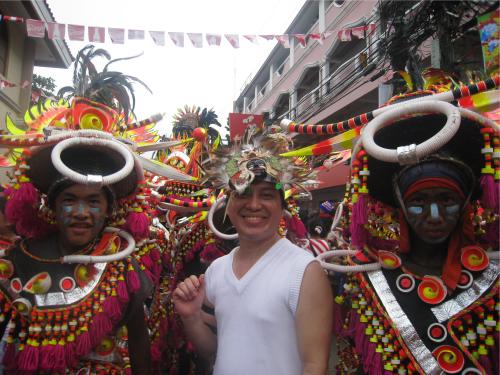Happy Thoughts (Tanka)
~
Physical looks fade,
Hard times, too, would come to pass,
But happy thoughts stay.
.
You left me good memories
I’m certain they will remain.

Ati-atihan Festival, January, 2008. Kalibo, Aklan, Philippines
(I had the chance to drop by and witness the colorful Ati-atihan festival during my recent home-coming)
—===***===—
Tanka(short poem) vs Renga/Renku(linked poem)
TANKA(or short poem) is the type of Japanese
literature which arose first in order. It has
been in vogue for over 20 centuries down to the
present day.
TANKA consists of 5 lines of 5,7,5,7,7 syllables
respectively. Tanka also attaches importance to
the seasons, so that there are sections for the
four seasons in any anthology of Tanka.
But it also contains several other sections,
such as Love, Journeys and uncertainties of life.
In which reference to the seasons is not necessary.
Again in Tanka, Love is an important subject, while
it is very rarely employed as a theme in Haiku. And
all Haiku dealing with Love, Journey and such other
human affairs contain season-words.
RENGA or later known RENKU or linked poem
appeared next. Origin dated far back to the
1st century composed jointly by an aged man and
by the heroic imperial prince Yamatotakem-no-Mikoto.
1st century to 1100’s – Renga’s popularity
gradually increased among courtiers and noblemen.
709-784 A.D. – Nara period
784-1186 A.D. – Heian period
1124 – 1141 A.D. – reign of Emperor Sutoko.
RENGA consists of 2 Hemistich. It is exactly the
same form as the Tanka or short poem, but it
it was sort of literary pastime.
The 1st Hemistich of 5,7,5 syllables was composed
by one man and the 2nd Hemistich of 7,7 syllables
by another. In contradiction to Tanka and Haiku
which are both serious verses, the Renga or linked
poem is comic and humorous in content and language,
making free use of pivot-words and associated words.
1186-1339 – Kamakura period, the rise of 2 anta-
gonistic groups that write linked poems:
Ushin-ha(or refined school) – serious in content
bore striking resemblance to Tanka(or short poem)
Mushin-ha(or unrefined school) – comocal and
humorous. Their poems come to be called Haikai-
no-Renga or simply Haikai or comic linked poem.
Often composed as yokno or after-entertainment
at Renga party.
Haikai – comic linked poems were often composed as
“Yokyo” or after-entertainment at renga parties.
Hokku – the first hemistich of a chain of linked
poems or starting Hemistich – it must be complete
sentence and contain a word referring to one or other
of the seasons.
Hokku is the most important of the Hemistichs and had
to be composed by the best poet of the joint writer.
1744-1748 – Enkyo era –
Hokku began often to be called: HAIKU – a cross between
Haikai and Hokku.
Haikai became to be called Renku or linked poem.
It is noteworthy fact that during the last half
century very few poets have written renku and it
may safely be said that the Renku is at present
an almost extinct and there are no signs of revival.
1868-1902 Masaoka Shiki can be traced to be the cause
of the decline of the Renku and is largely attributed
to him. He maintained that the Renku or linked poems
is not literature and did not essay his hand in that
direction.



Recent Comments